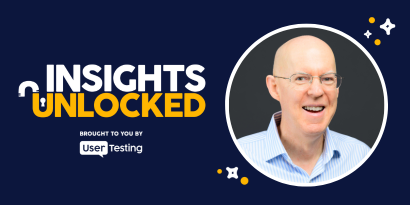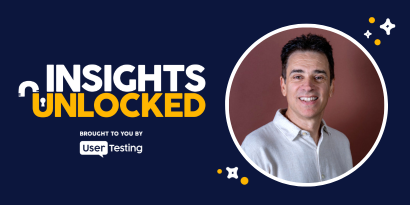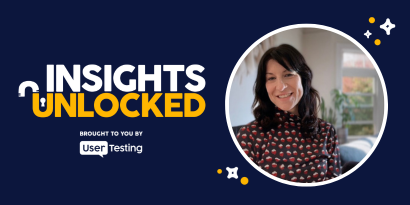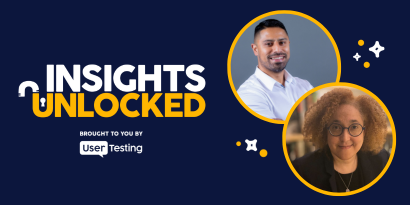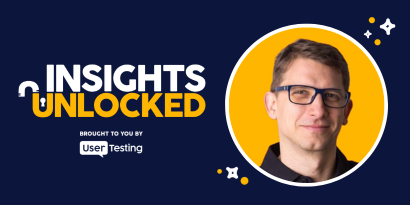
Episode 189 | September 22, 2025
Customer research tips for SaaS growth with Asia Orangio
Learn how Asia Orangio uses fast customer research to solve SaaS growth challenges and boost retention with insights that drive real action.
Unlocking SaaS growth with fast, focused customer research
Most SaaS companies don’t have a growth problem—they have a listening problem. They’re sitting on gold mines of customer data and behavioral metrics, yet they struggle to act because they’re missing one thing: the human story behind the numbers.
In a recent Insights Unlocked podcast episode, Asia Orangio, founder and CEO of DemandMaven, joined UserTesting’s Lija Hogan to unpack how fast, lightweight customer research can unlock product-led growth, improve retention, and bring focus to scattered teams.
With over 100 SaaS companies under her belt, Asia has seen what works—and what doesn’t—when it comes to troubleshooting growth. And at the heart of her approach? Conversations. Real ones.
“Behind every KPI you want to improve, there’s a set of conversations you can have,” she said. “You can make the number talk.”
Let’s dive into some of the most actionable insights from their conversation and explore how customer interviews and qualitative research can help your team break through stagnation and scale with clarity.
Why data alone isn’t enough
If you’ve ever stared at a dashboard and wondered why churn is creeping up or conversion is slipping, you’re not alone. Metrics give you signals, but rarely the story.
Asia explained that she had her own turning point years ago while consulting on demand generation campaigns for SaaS clients. Even when she helped teams flood the top of the funnel, they weren’t seeing retention or sustainable growth.
“We were only going to retain a very small percentage of them after six months. That’s when I realized, all this marketing work might not be the right work.”
This realization pushed her deeper into product-led growth, where customer experience, product value, and user success become the real levers for scale.
The missing link? Human insight. Teams needed to talk to their customers, not just analyze them.
Customer interviews: the secret weapon for SaaS growth
Asia believes that meaningful customer research doesn’t need to be complex, expensive, or time-consuming. She routinely helps clients uncover powerful insights with just 10–20 interviews, often conducted in under two weeks.
And yet, many founders and product leaders avoid interviews altogether, believing that:
- Their challenges are too unique for existing frameworks
- There’s no clear process for customer insight
- Research will take too long to deliver value
Asia has spent the last few years systematically breaking these myths.
“Research can happen extremely fast,” she said. “I've proven that several times over. I can get people on the phone in 24 hours.”
By tailoring research design to the specific problem at hand, like poor 12-month retention or low upsell conversion, Asia helps teams focus on the conversations that matter most. Each interview becomes a window into the friction points, unmet needs, and unexpected opportunities hidden within the customer journey.
ON-DEMAND WEBINAR
Tactical (and practical) tips to get fast feedback for better marketing
Founders in the room: a game-changer for action
One of the most compelling takeaways from the episode is how Asia shifted her own stance on stakeholder involvement in user interviews. For years, she asked founders and executives to stay out of the room, fearing they’d bias the conversation or intimidate participants.
But after repeated challenges getting buy-in post-research, she flipped her approach.
“It wasn’t until the founder watched a user struggle through something that we saw real change,” she said. “They’d start coding fixes during the interview.”
Now, she actively encourages CEOs, product leads, and marketers to sit in (cameras off) during live interviews. It creates empathy, accountability, and, most importantly, momentum.
Watching someone churn, struggle, or express confusion in real time brings a level of urgency that no PowerPoint deck ever could.
Designing customer research that gets results
Asia takes a structured yet nimble approach to research. Her go-to framework starts with a simple question:
What problem are we trying to solve?
From there, she identifies:
- Who is most directly connected to that problem
- What a “success case” looks like (e.g., long-term customers)
- What failure or churn looks like (e.g., early exits, inactive users)
- A manageable sample size (often just 5 interviews per segment)
Whether it’s a UX research study, churn interview, or a new product test, the goal is to balance depth with speed, and to leave room for course corrections.
She recounted a recent project where early interviews revealed a mismatch between the offer and the intended customer segment. Instead of pushing through with 15 pre-scheduled calls, they pivoted mid-way, revised the offer, and continued with a more relevant batch of users.
“It’s all about trade-off management,” she said. “The faster you learn, the sooner you can steer the ship.”
GUIDE
Competitive analysis with UserTesting
Churn is uncomfortable—but critical
Few teams want to talk to customers who’ve churned. It’s awkward. It’s emotional. But it’s also essential.
Asia likens churn interviews to therapy. She keeps them short (around 30 minutes), compensates generously, and creates a space where former customers feel safe expressing frustration or even indifference.
Her advice? Be a dispassionate but compassionate analyst.
- Don’t try to defend the product
- Don’t correct misunderstandings in the moment
- Don’t try to re-sell them
Instead, listen for patterns. Stack the pain points. Identify the moments where the perceived value started to break down.
“Usually what you find is it’s never just one thing,” she noted. “It’s five to ten little things that stacked up.”
From insights to action: how to prioritize
Customer research often uncovers a long list of issues, opportunities, and unmet needs. Asia’s approach to prioritization starts with a key distinction:
- Value generators: New jobs to be done that expand product value and retention
- Quality-of-life fixes: Usability improvements, feature enhancements, and small frustrations
She also breaks churn drivers into:
- Controllables: Onboarding gaps, missing features, support friction
- Uncontrollables: Budget cuts, job changes, external events
By mapping these findings to retention strategy or growth strategy goals, and tying them to revenue loss or opportunity, teams can make confident decisions about what to tackle first.
“You don’t need statistical significance to take action,” she emphasized. “Not in our world.”
Customer research is a choice and a competitive advantage
Too many teams delay research because they think they need permission, resources, or six-month timelines. Asia argues that it’s not a constraint, it’s a choice.
“You can decide to move fast,” she said. “Research is not what slows you down. It’s what speeds up your clarity.”
Final thoughts
If your team is spinning its wheels (adding features, testing headlines, adjusting pricing) without seeing real traction, consider pausing to listen. Not just to the data, but to the people behind it.
Asia Orangio’s approach to customer insights and product-led growth reminds us that the answers are often already within reach. You just have to ask the right people the right questions, and be open to what you hear.
“Usually what ends up happening is the person you talk to says, ‘Wow, that felt so good just to talk to someone and share this.’ That’s how you know you did a good job,” Asia concluded.
Episode links
- Asia Orangio on LinkedIn
- Lija Hogan on LinkedIn
- DemandMaven website
- DemandMaven podcast
- Nathan Isaacs on LinkedIn
- Take your research to the next level – In this on-demand webinar, learn how to elevate your research strategy, leverage new platform features, and drive impactful generative insights.
- The executive’s guide to human insight – A practical guide on integrating fast, real‑time customer feedback throughout the product development process to accelerate decision‑making.
- Build products customers love with continuous discovery – In this podcast episode, Teresa Torres talks about getting customer input earlier in the product development lifecycle to better dial in product market fit.
- 6 business benefits of scaling customer research – This blog post explores how expanding access to customer insight across an organization can improve discovery, design, launch, organizational buy‑in, team success, and product quality.
On-Demand webinar


